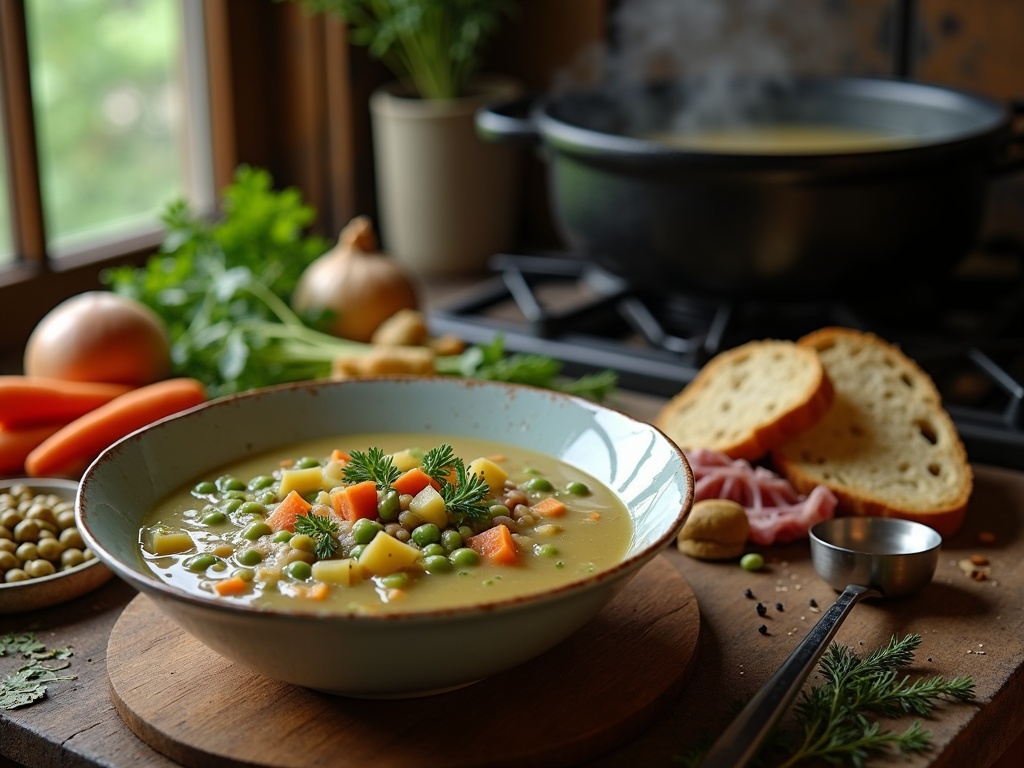Pea and ham soup stands as a timeless comfort food with a rich heritage dating back to medieval Europe, where simple ingredients combined to create a hearty, nourishing meal. This classic pairing of sweet peas and savory ham has crossed generations and cultures, growing from peasant cooking to a beloved staple that balances simplicity with remarkable flavor depth.
Find In This Article
Key Takeaways
- Nutritional Benefits: The nutritional profile of pea and ham soup includes substantial fiber, complete protein, and vitamins A, C, and K, delivering approximately 20 grams of protein per serving.
- Importance of Ingredients: Quality ingredients make a significant difference—dried split peas create the ideal creamy texture, while a ham hock or bone infuses the broth with deep smoky flavor.
- Preparation Tips: Proper preparation, including sorting and rinsing peas, and patient simmering (60-90 minutes) are crucial for developing the soup’s signature texture and taste.
- Common Mistakes: Errors to avoid include adding salt too early (which can prevent peas from softening), using insufficient liquid, and not stirring occasionally to prevent scorching.
- Customization Options: The soup welcomes creative adaptations with various vegetables, herbs, and garnishes, making it easily customizable while maintaining its comforting essence.
What Makes This Classic Comfort Soup Special
The humble pea and ham soup has maintained its status as a beloved dish across generations for good reasons. This classic combination dates back centuries, with roots in peasant cooking where economical ingredients created hearty, satisfying meals.
A Recipe Steeped in History
Pea and ham soup originated in medieval Europe when dried peas became a staple food source. Farmers discovered that adding leftover ham bones created a rich, flavorful broth that transformed simple peas into something extraordinary. The practice spread across cultures — from British pea soup with ham hocks to Dutch erwtensoep and French cassoulet variations. What began as a practical way to use every part of a butchered pig evolved into a dish that transcends class boundaries, appearing on tables from farmhouses to fine dining establishments.
The genius of this pairing lies in its simplicity — the sweetness of peas balances perfectly with the savory depth of cured ham. I’ve found that allowing the ingredients to simmer slowly together creates a symphony of flavors impossible to replicate with shortcuts.
Nutritional Powerhouse in a Bowl
Beyond its incredible taste, this soup offers impressive nutritional benefits:
- Dried peas provide substantial fiber, supporting digestive health and creating longer-lasting fullness
- The protein combination from peas and ham creates a complete amino acid profile
- Peas contribute vitamins A, C, and K, plus minerals like manganese and potassium
- The slow cooking process extracts collagen and minerals from ham bones, supporting joint health
- A typical serving delivers around 20 grams of protein while remaining relatively low in calories
This nutritional density explains why pea and ham soup remains a practical choice for health-conscious cooks. I particularly appreciate how it provides sustained energy during cold months when our bodies crave heartier meals.
The staying power of this soup also comes from its versatility. You can create simple variations like adding diced carrots for sweetness or experiment with fresh herbs like thyme or bay leaves. Some cooks even add a splash of vinegar at the end to brighten flavors, similar to how gazpacho soup uses acid to enhance its taste profile.
In today’s fast-paced world, the slow-cooked nature of this soup represents a return to food traditions that connect us with our past while nourishing our present. Its enduring popularity proves that sometimes the most basic combinations create the most magical results.
Everything You Need To Make It
The beauty of pea and ham soup lies in its simple ingredients that combine to create a deeply satisfying meal. I’ve found that focusing on quality ingredients makes all the difference in this classic comfort food.
Core Ingredients
Yellow or green split peas form the foundation of this hearty soup. Either variety works well, though green split peas tend to maintain their color better while yellow ones create a more subdued golden hue. I prefer using dried peas rather than fresh, as they break down during cooking to create that perfect thick, creamy texture that’s characteristic of a good pea soup.
The star flavor-maker is undoubtedly the ham component. A meaty ham hock works wonders, infusing the broth with smoky depth and providing tender meat to shred into the soup. Don’t have a ham hock? A leftover ham bone from a holiday meal does the job beautifully too. The bone imparts incredible flavor as it simmers.
No great soup exists without aromatics. The classic mirepoix combination of onions, carrots, and celery creates the flavor base that elevates this soup. Dice these vegetables uniformly to ensure even cooking. I like to sauté them gently before adding other ingredients to release their sweet flavors.
Garlic and bay leaves provide additional layers of flavor. Fresh garlic cloves, minced or crushed, add warmth and depth, while bay leaves contribute a subtle herbal note that ties everything together. Remember to remove the bay leaves before serving!
For the liquid component, you have options. A good quality chicken or vegetable stock provides an immediate flavor boost, but water works perfectly well too—especially with a flavorful ham hock doing most of the heavy lifting. If using water, you might need to be more generous with seasonings.
Seasoning and Finishing Touches
Salt and pepper are essential, but approach salting with caution. Ham can be quite salty, so I usually wait until the end of cooking to adjust the salt level. Freshly ground black pepper, however, can be added early in the cooking process.
Fresh herbs are optional but can brighten the soup considerably. A handful of chopped parsley stirred in at the end adds color and freshness. Other herbs that work well include:
- Thyme (a few sprigs added during cooking)
- Fresh mint (particularly good with green split peas)
- Chives (snipped on top just before serving)
- Marjoram (adds a subtle oregano-like note)
For a creamier texture, consider using an immersion blender to partially blend the soup once the peas have softened. This creates a luxurious consistency while maintaining some texture.
If you’d like to explore other satisfying soups for your repertoire, cold gazpacho soup offers a refreshing alternative for warmer months, while homemade carrot soup provides another economical and nutritious option.
Remember that pea and ham soup often tastes even better the next day, as flavors meld and deepen overnight. I typically make a large batch for exactly this reason—it’s the gift that keeps on giving throughout the week.
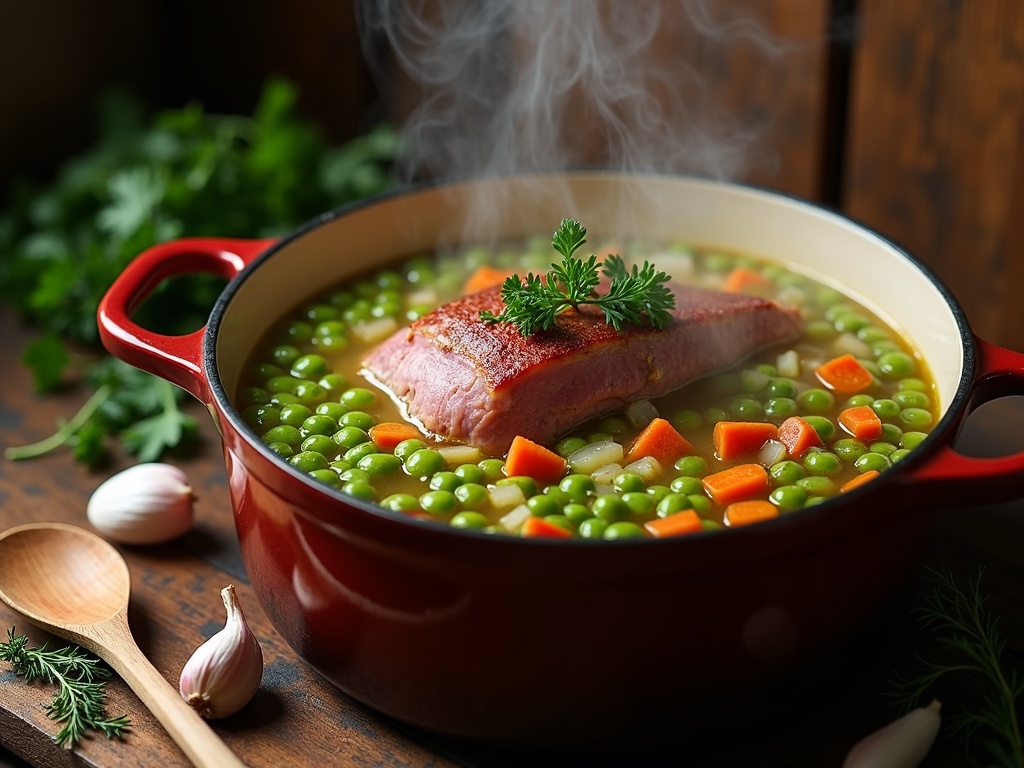
The Step-By-Step Cooking Process
Creating a perfect pea and ham soup starts with understanding each step of the process. I’ll guide you through the entire journey from prep to plate to ensure your soup turns out flavorful and comforting.
Preparing Your Ingredients
Sorting and rinsing dried split peas isn’t just a formality—it’s essential for the best texture and flavor. I always spread my peas on a clean kitchen towel or large plate and carefully inspect them, removing any small stones or debris that might have made their way into the package.
Once sorted, I place the peas in a colander and rinse them under cold running water until it runs clear. This removes any dust and surface starch. Some recipes call for soaking the peas for several hours or overnight, which can reduce cooking time. If you’re short on time, you can skip this step, but expect to simmer your soup a bit longer.
The vegetable prep is just as important. I start by finely dicing onions, celery, and carrots—the classic mirepoix that forms the flavor foundation. Garlic, minced fresh or from a jar, adds another dimension. For an extra aromatic punch, I sometimes include fresh thyme or bay leaves.
For the star ingredient, you’ll need good-quality ham. A meaty ham hock is traditional, but smoked ham shanks or leftover holiday ham work beautifully too. Cut any large pieces into bite-sized chunks to distribute the smoky flavor throughout the soup.
The Cooking Method
The cooking process follows a sequence that builds flavor at each stage:
- Heat olive oil or butter in a large heavy-bottomed pot over medium heat.
- Add the diced onions and sauté until translucent, about 3-4 minutes.
- Introduce celery and carrots, cooking for another 5 minutes until they begin to soften.
- Add minced garlic and cook for just 30 seconds until fragrant (be careful not to burn it).
- Place the ham hock or ham pieces into the pot, allowing them to release some flavor.
- Add the rinsed split peas and stir to coat them with the aromatic oil.
- Pour in chicken or vegetable stock, using enough to cover the ingredients by about an inch.
- Bring to a boil, then reduce to a gentle simmer.
The simmering stage is where patience pays off. Split peas typically need 45–60 minutes to break down and create that signature thick texture. I keep the pot partially covered and stir occasionally to prevent sticking. If the soup gets too thick during cooking, I’ll add more stock or water a half cup at a time.
If you’re using a ham hock, remove it after about 40 minutes of simmering, let it cool slightly, then shred the meat and return it to the pot, discarding bones and fat.
The final seasoning is where I make this soup my own. While the ham provides plenty of saltiness, I taste and adjust with freshly ground black pepper, a pinch of thyme, and sometimes a splash of apple cider vinegar to brighten the flavors. Some cooks add a bay leaf during simmering for depth, but remember to remove it before serving.
You’ll know your soup is done when the peas have mostly dissolved, creating a naturally thick consistency. I prefer some texture, so I stop cooking when some peas still retain their shape. For a smoother soup, you could use an immersion blender for a few quick pulses.
Pea and ham soup shares the same comforting quality as a hearty carrot soup recipe, but with a distinctly savory profile that makes it perfect for colder months. Like its Spanish cousin gazpacho soup (though served hot instead of cold), it celebrates simple ingredients transformed through thoughtful preparation.
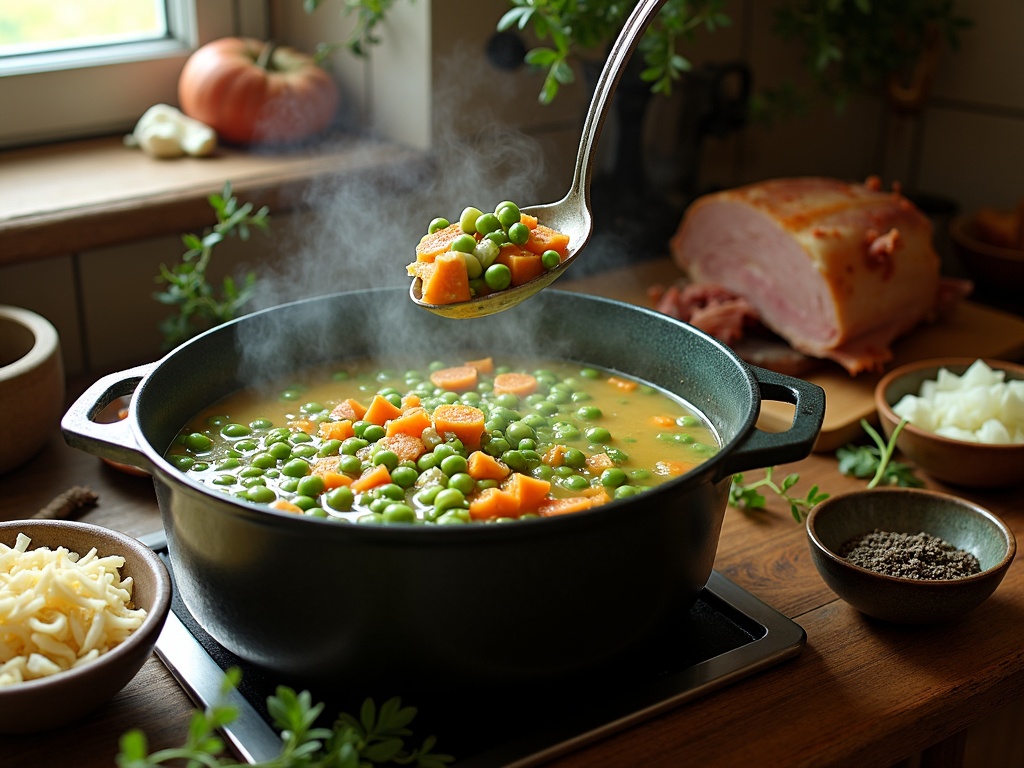
Common Mistakes To Watch For
Pea and ham soup is a comforting classic that’s relatively easy to prepare, but there are several pitfalls that can turn your hearty meal into a disappointing dish. I’ve learned these lessons through trial and error, and I’m sharing them to help you avoid the same mistakes.
Critical Errors That Affect Your Soup’s Success
Not soaking your dried peas properly is perhaps the most common mistake when making soup recipes with dried legumes. Split peas generally need at least 4 hours of soaking, though overnight is ideal. Skip this step and you’ll end up with hard, undercooked peas that never fully soften no matter how long you simmer them. The soaking process rehydrates the peas and significantly reduces cooking time. If you’re in a hurry, use the quick-soak method: boil the peas for 2 minutes, then let them sit covered for an hour.
Adding salt too early in the cooking process is another mistake that can ruin your soup. Salt can toughen the peas and prevent them from softening properly. I always wait until the peas are tender before adjusting the seasoning. This simple timing change makes a remarkable difference in the final texture of your soup.
Patience is key when making pea and ham soup. Rushing the cooking process prevents the flavors from fully developing and the peas from breaking down to create that creamy consistency. The soup needs time—typically 60–90 minutes of gentle simmering—for the magic to happen. The ham needs time to release its savory goodness into the broth, and the peas need time to soften and thicken the soup naturally.
Using too little liquid is a mistake I made early on. Dried peas absorb a significant amount of liquid as they cook, and without enough broth or water, you’ll end up with a thick paste rather than a soup. Start with more liquid than you think you need, as it’s always easier to reduce a soup that’s too thin than to correct one that’s too thick. I generally use a ratio of one part peas to four parts liquid.
Many cooks forget to stir their soup occasionally during cooking. This can lead to peas sticking to the bottom of the pot and scorching, which imparts a burnt flavor to the entire batch. I make it a habit to stir every 15–20 minutes, scraping the bottom of the pot each time to prevent sticking. This is especially important as the soup thickens.
Beyond these common mistakes, I’ve found that choosing the right ham can make or break your soup recipe. A ham hock or bone provides more flavor than plain diced ham, as the collagen and marrow in the bone enrich the broth. However, if you only have diced ham, you can enhance the flavor with a good quality stock instead of water.
Overcrowding the pot is another error to avoid. The ingredients need space for proper heat circulation and even cooking. I use a pot that’s large enough to allow for at least 2 inches of space at the top after adding all ingredients.
By avoiding these common mistakes, you’ll create a delicious pea and ham soup with perfect consistency and depth of flavor. The richness of the ham complements the earthiness of the peas, creating a satisfying meal that improves even more when reheated the next day.
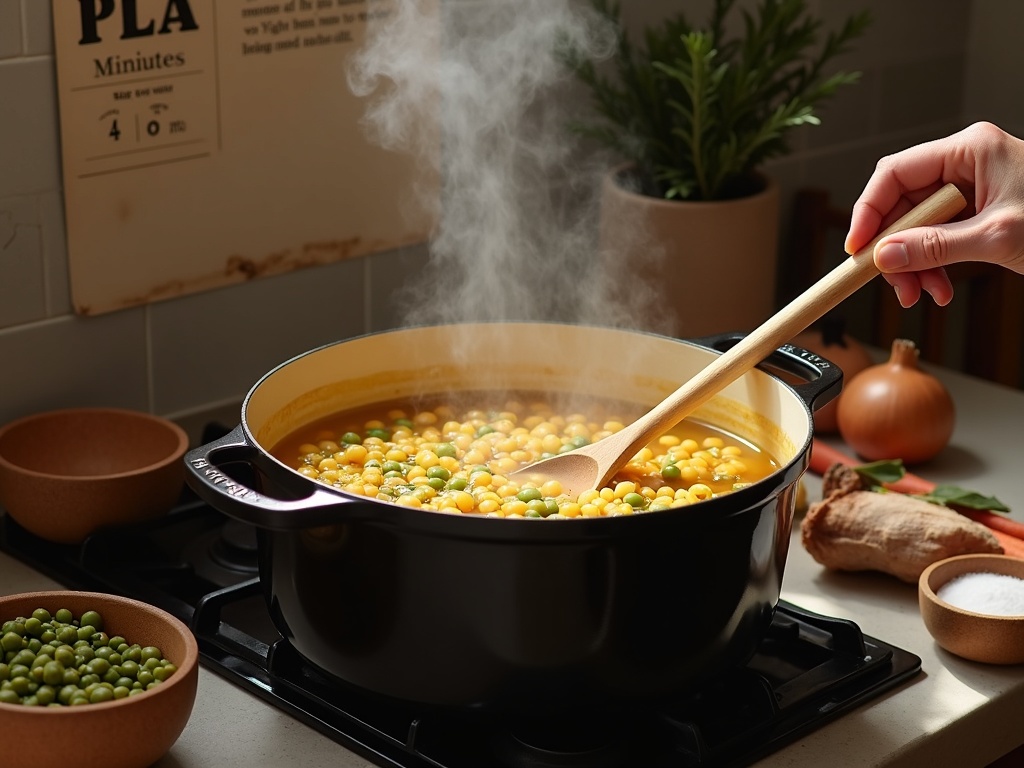
Helpful Tips For Perfect Results
Selecting the Best Ingredients
The foundation of a memorable homemade soup starts with quality ingredients. For pea and ham soup, the cut of ham makes a significant difference in flavor depth.
I’ve found that ham hocks deliver exceptional results because they contain bone, fat, and collagen that break down during cooking, creating a rich broth. Smoked ham bones also impart a delicious smoky flavor that complements the sweetness of peas beautifully.
For meatier chunks in your soup, ham shanks are ideal—they provide more meat while still offering that bone-in flavor boost. If you’re pressed for time, leftover holiday ham works wonderfully too, just make sure to include some bone pieces for maximum flavor.
Perfecting Texture and Storage
Getting the right thickness for your pea and ham soup can be tricky. If your soup seems too thin, try these fixes:
- Simmer uncovered for 15-20 minutes to reduce and concentrate flavors
- Blend a portion of the soup and return it to the pot
- Add a potato early in the cooking process to naturally thicken as it breaks down
- Use a cornstarch slurry (1 tbsp cornstarch mixed with cold water) for quick thickening
For soup that’s too thick, simply add more stock or water until you reach your desired consistency.
Proper storage keeps your soup fresh and flavorful. Store cooled soup in airtight containers in the refrigerator for up to 4 days. The flavor actually improves after a day as ingredients meld together.
Freezing pea and ham soup is straightforward but requires some care. Let the soup cool completely before transferring to freezer-safe containers, leaving a half-inch of space for expansion. It keeps beautifully for up to 3 months.
When ready to enjoy again, thawing in the refrigerator overnight provides the best results. For reheating, gentle warming on the stovetop over medium-low heat prevents scorching. Stir occasionally and add a splash of water or stock if needed to restore the original consistency.
If using a microwave, cover the soup and heat in 1-minute intervals, stirring between each until heated through. The soup may thicken after freezing, so don’t hesitate to adjust consistency with additional liquid.
These techniques ensure your homemade soup maintains its flavor and texture from the first bowl to the last.
Making It Your Own
Transforming basic pea and ham soup into a personalized masterpiece is both simple and rewarding. I’ve found that this hearty classic welcomes creativity, allowing home cooks to adapt the recipe to their tastes, dietary needs, and what’s available in their pantry.
Creative Vegetable and Seasoning Twists
The foundation of pea and ham soup can be enhanced with various vegetable additions that complement the natural sweetness of peas. I’ve experimented with these vegetable variations with great results:
- Diced carrots for added sweetness and color contrast
- Celery for a subtle aromatic flavor
- Leeks instead of standard onions for a milder, more complex taste
- Small cubes of potato to create a thicker, more substantial texture
- Fresh or frozen corn kernels for sweetness and texture variety
- Finely chopped kale or spinach stirred in during the final minutes of cooking
While the traditional seasoning profile of pea and ham soup centers on bay leaves, salt, and pepper, I’ve discovered that altering the seasoning can dramatically shift the character of this soup. Consider these alternative flavor directions:
- Fresh thyme and rosemary for an herbaceous Mediterranean profile
- Smoked paprika for an additional layer of smokiness
- A dash of apple cider vinegar to brighten the flavors
- Garlic powder or roasted garlic for depth
- Red pepper flakes for gentle heat
- A tiny pinch of nutmeg to enhance the sweetness of the peas
If you’re looking for other flavorful soup options, you might also enjoy trying a refreshing Spanish gazpacho recipe for summer or a vibrant homemade carrot soup for fall.
Serving and Presentation Suggestions
The way you serve pea and ham soup can elevate it from a humble meal to an impressive dish. I’ve collected these serving suggestions that make a significant difference:
Garnishing options can transform both the appearance and flavor profile of your soup:
- Crispy bacon bits or ham pieces for textural contrast
- A dollop of crème fraîche or sour cream for richness
- Fresh mint leaves to highlight the pea flavor
- Toasted croutons for crunch
- A drizzle of extra virgin olive oil
- Finely sliced green onions or chives
- A sprinkle of grated Parmesan cheese
- Lemon zest for brightness
The sides you choose to serve with your pea and ham soup can create a complete dining experience. I’ve paired my soup with:
- Warm crusty bread or sourdough toast
- Cheese scones or savory muffins
- A simple green salad with a light vinaigrette
- Grilled cheese sandwiches for dipping
- Cornbread for a Southern touch
- Savory herb biscuits
- Garlic bread for a crowd-pleasing option
For a more formal presentation, I serve the soup in warmed bowls with the garnishes arranged artistically on top. For casual gatherings, a soup station with multiple garnish options allows guests to customize their bowls.
Don’t forget about texture—contrasting the smoothness of pureed pea soup with crunchy elements creates an interesting eating experience. If you prefer a chunky soup, you can reserve some of the cooked peas and ham to add back after blending.
The beauty of pea and ham soup lies in its adaptability. Whether you’re making it for a weeknight dinner or a special occasion, these tweaks and additions allow you to create a version that feels uniquely yours while honoring this classic comfort food’s beloved tradition.
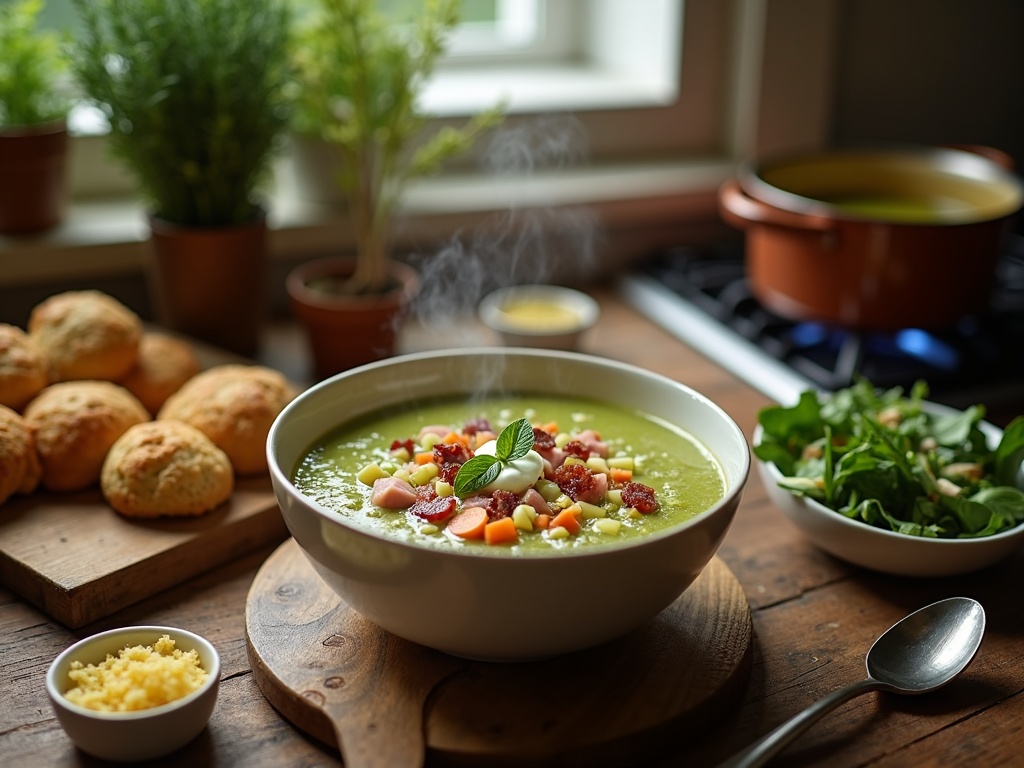
Troubleshooting Your Soup
Even the most experienced home cooks occasionally face challenges with pea and ham soup. I’ve encountered plenty of soup mishaps over the years and learned how to fix common issues without starting over. These practical solutions will help you rescue your soup and turn potential disappointments into delicious meals.
Consistency and Texture Issues
A perfect pea and ham soup should have a satisfying thickness—not too watery and not too dense. If your soup turns out too thick, I recommend adding small amounts of chicken or vegetable stock, about a quarter cup at a time, stirring well after each addition. Hot water works in a pinch, but stock maintains the flavor profile. For a creamier texture without changing the consistency significantly, try adding a splash of cream or a dollop of Greek yogurt just before serving.
Undercooked peas can ruin the texture of your soup, leaving hard bits that detract from the experience. If you’ve already blended your soup and discover some peas aren’t fully cooked, simply return the pot to low heat and simmer for another 15-30 minutes. The extended cooking time allows the starches in the peas to break down properly. For particularly stubborn batches, add a pinch of baking soda—this slightly alkaline ingredient helps soften the peas faster without affecting flavor.
When making split pea soup, remember that older dried peas take significantly longer to soften. In future batches, consider soaking dried peas overnight if you’ve had issues with undercooked legumes in your homemade soup recipe.
Flavor Adjustments
Seasoning can make or break your pea and ham soup experience. Here are specific ways to correct common flavor issues:
If your soup lacks depth, try these additions:
- A splash of apple cider vinegar or lemon juice brightens the flavors
- Fresh herbs like thyme or mint add complexity
- A teaspoon of Dijon mustard enhances the savory aspects
- Sautéed garlic or caramelized onions provide aromatic depth
- A parmesan rind simmered in the soup adds umami notes
For a soup that’s too salty (a common issue when using ham hocks or commercial stocks), dilution is your friend. Add unsalted liquid along with more vegetables like carrots or potatoes, which absorb salt while cooking. A tablespoon of unsweetened cream or a peeled, quartered potato added to the simmering soup can help absorb excess salt—just remember to remove the potato before serving.
When rescuing bland soup recipes, I often reach for umami-rich ingredients rather than more salt:
- A tablespoon of tomato paste
- A dash of soy sauce (use sparingly)
- A sprinkle of nutritional yeast
These can transform a flat-tasting soup without making it saltier.
For pea and ham soup specifically, don’t underestimate the power of black pepper. Freshly cracked black pepper added at the end of cooking provides a warming counterpoint to the sweetness of the peas and smokiness of the ham.
If your soup tastes like it’s missing something but you can’t identify what, try adding a small amount of acid—a teaspoon of white wine vinegar or a squeeze of lemon juice often balances flavors perfectly and makes everything taste more vibrant without changing the soup’s character.
Remember that seasoning is highly personal, so taste frequently as you make adjustments and allow flavors to meld for a few minutes between additions.

